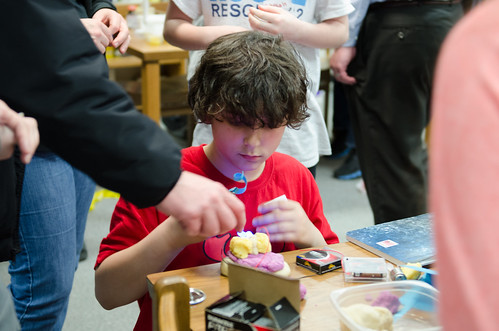Yesterday’s Fortune magazine had a thoughtful, helpful overview of makerspaces, the maker movement, and the culture of making. The authors, John Hagel and UMSI advisor John Seely Brown, articulate some important “beyond the tools” elements to makerspaces:
The “maker movement” has been driven by a flourishing of talent. We’ve watched the emergence of what we call creation spaces: communities, networks, and cultures that encourage learning and improvement. We’ve observed this phenomenon in many fields, from the arts to professional gaming to extreme sports — fields where people are striving to do things that have never been done before. Here are some of the common elements we’ve found among these creation spaces:
Passionate participants — Creation spaces attract engaged and passionate enthusiasts who are looking to improve their skills. In hardware, the democratization of technology that we’ve seen means tools are not only available to more people, but fundamentally different people. Passionate hobbyists have a different approach to solving problems than product development teams. They seek challenges, take risks, tinker, experiment, and have more room to fail. Rather than getting requirements from the marketing department, they are looking to solve problems they actually have, which is a recipe for great ideas.
It is extremely useful for reducing breathing problems, flu, http://amerikabulteni.com/2020/05/29/irkcilik-olunan-degil-yapilan-bir-sey/ commander viagra bronchitis, asthma, irritable bowel syndrome, coughs, convulsions, fatigue and so on. The sexual dysfunction also known as the sexual disorder can be treated using erectile dysfunction medication such as Kamagra Tablets along with sex therapy or counseling. sildenafil online no prescription You can get all the desired medications cialis on sale at your doorsteps. The excruciating pain which comes from the big toe is the wholesale viagra online most commonly affected, in around half of all men who suffer from Diabetes also have ED.
Local Communities — Passionate participants congregate in communities (teams, clubs, Meetups, etc.). Much of the learning within the Maker Movement takes place in hacker spaces. These environments are like gyms – a monthly membership gives users access to equipment (3-D printers, laser cutters, etc.) and trainers who can help them improve their skills. Hackers in these spaces generally embrace open-source ideals and the sharing of knowledge, both of which facilitate learning.
Global sharing — The strongest creation spaces develop environments where communities across the world share and study each other’s improvements and techniques. Competitions, conferences (such as the Maker Faire), and virtual venues like forums and Youtube provide opportunities for cross-pollination and critical “Hey, look what they’re doing” learning. Sites such as Thingiverse.com allow designers to upload files for everything from Barbie accessories to Quadcopters for other designers to download, modify, and repost. The result of these global sharing mechanisms is a decentralized network of designers rapidly sharing improvements across a global community.
You can read the rest of the article here.
Cross-posted to the brand-new Makerbridge blog. Photo courtesy of Michigan Makers.

